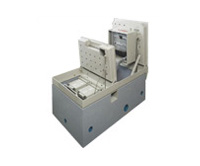
UC-Cabinet – Subterranean enclosures
As we share the same space with an ever increasing number of people, public areas like streets, squares and parks will be used with increasing intensity, creating a strong demand for solutions that manage to avoid obstacles at street level as much as possible.
GE Power Protection, being a major supplier of street level distribution switchboxes for telecommunications, energy and CATV distribution connectivity, has developed UC-Cabinet enclosures for this purpose. UC-Cabinet enclosures are switchboxes that are installed underground and are suitable for installing all kinds of equipment for permanent or temporary connectivity. The distinguishing characteristic of UC-Cabinet enclosures is that they can remain underground both in active and passive condition, which means that they do not constitute any obstacle whatsoever.
These UC-Cabinet enclosures can be employed, among other applications, for temporary mains hook-ups for the benefit of markets, fairs or other events. However, they are also eminently suitable for permanent connections, low voltage energy distribution, glass fibre connections for a variety of IT related applications, or for installing supporting equipment for mobile telephony.
The tops of the underground UC-Cabinet enclosures can be finished in such a way that they become an aesthetically pleasing part of their surroundings.
UC-Cabinet – The principle of the diving Bell
The principle of the UC-Cabinet enclosure is based on the same principle as the diving bell.
A diving bell is a 5-walled, hermetically sealed compartment.
Under normal conditions, the opening is at the bottom, so that in case of a rising water table the underside is closed off completely by water.
As the water table rises, the air present in the sealed unit will be compressed until an equilibrium is reached between the air pressure and the force exerted by the rising water, at which point the water will rise no further (Boyle’s Law).
Even if the UC-Cabinet enclosure becomes fully immersed in water, for example in the case of flooding, heavy rains etc. the air bubble trapped in the sealed compartment will remain large enough to prevent the plastic enclosures in which the equipment has been installed from coming into contact with water.
